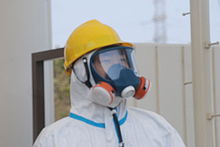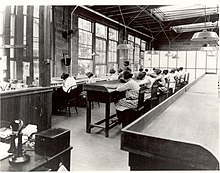


Nuclear labor issues exist within the international nuclear power industry and the nuclear weapons production sector worldwide, impacting upon the lives and health of laborers, itinerant workers and their families.[1][2][3]
A subculture of frequently undocumented workers do the dirty, difficult, and potentially dangerous work shunned by regular employees. They are called in the vernacular Nuclear Nomads, Bio-Robots, Luminizers, Glow Boys, Radium Girls, the Fukushima 50, Liquidators, Atomic Gypsies, Gamma Sponges, Nuclear Gypsies, Genpatsu Gypsies, Nuclear Samurai and Jumpers.[4] When they exceed their allowable radiation exposure limit at a specific facility, they often migrate to a different nuclear facility. The industry implicitly accepts this conduct as it can not operate without these practices.[5][6] The World Nuclear Association states that the transient workforce of "nuclear gypsies" – casual workers employed by subcontractors – has been "part of the nuclear scene for at least four decades."[7]
Existent labor laws protecting worker's health rights are not always properly enforced.[8] Records are required to be kept, but frequently they are not. Some personnel were not properly trained resulting in their own exposure to toxic amounts of radiation. At several facilities there are ongoing failures to perform required radiological screenings or to implement corrective actions.
Many questions regarding these nuclear worker conditions go unanswered, and with the exception of a few whistleblowers, the vast majority of laborers – unseen, underpaid, overworked and exploited – have few incentives to share their stories.[9] The median annual wage for hazardous radioactive materials removal workers, according to the U.S. Bureau of Labor Statistics was $37,590 in 2014 – $18 per hour.[10] A 15-country collaborative cohort study of cancer risks due to exposure to low-dose ionizing radiation, involving 407,391 nuclear industry workers showed significant increase in cancer mortality. The study evaluated 31 types of cancers, primary and secondary.[11]
- ^ Efron, Sonni (December 30, 1999). "System of Disposable Laborers". Los Angeles Times. Retrieved 28 March 2014.
- ^ Wald, Matthew L. (January 29, 2000). "U.S. Acknowledges Radiation Killed Weapons Workers". New York Times. Retrieved 28 March 2014.
- ^ Iwaki, H.T. (October 8, 2012). "Meet the Fukushima 50? No, you can't". The Economist. Retrieved 28 March 2014.
- ^ Bagne, Paul (November 1982). "The Glow Boys: How Desperate Workers are Mopping Up America's Nuclear Mess". Mother Jones. VII (IX): 24–27. Retrieved 28 March 2014.
- ^ Efron, Sonny (1999-12-30). "System of Disposable Laborers". Los Angeles Times. Retrieved 1 April 2014.
- ^ Petersen-Smith, Khury. "Twenty-first century colonialism in the Pacific". IRS. Retrieved 1 April 2014.
- ^ World Nuclear Association. "Fukushima Accident". WNA. Retrieved 23 August 2014.
- ^ Jacob, P.; Rühm, L.; Blettner, M.; Hammer, G.; Zeeb, H. (March 30, 2009). "Is cancer risk of radiation workers larger than expected?". Occupational and Environmental Medicine. 66 (12): 789–796. doi:10.1136/oem.2008.043265. PMC 2776242. PMID 19570756.
- ^ Krolicki, Kevin and Chisa Fujioka. "Japan's "throwaway" nuclear workers". Reuters, MMN: Mother Nature Network. Archived from the original on 2 September 2011. Retrieved 1 April 2014.
- ^ Bureau of Labor Statistics. "Hazardous Materials Removal Workers". Retrieved 1 April 2014.
- ^ Cardis, E.; Vrijheid, M.; Blettner, M.; Gilbert, E.; Hakama, M.; Hill, C.; Howe, G.; Kaldor, J.; Muirhead, C. R.; Schubauer-Berigan, M.; Yoshimura, T.; Bermann, F.; Cowper, G.; Fix, J.; Hacker, C.; Heinmiller, B.; Marshall, M.; Thierry-Chef, I.; Utterback, D.; Ahn, Y-O.; Amoros, E.; Ashmore, P.; Auvinen, A.; Bae, J-M.; Bernar, J.; Biau, A.; Combalot, E.; Deboodt, P.; Sacristan, A. Diez; Eklöf, M.; Engels, H.; Engholm, G.; Gulis, G.; Habib, R. R.; Holan, K.; Hyvonen, H.; Kerekes, A.; Kurtinaitis, J.; Malker, H.; Martuzzi, M.; Mastauskas, A.; Monnet, A.; Moser, M.; Pearce, M. S.; Richardson, D. B.; Rodriguez-Artalejo, F.; Rogel, A.; Tardy, H.; Telle-Lamberton, M.; Turai, I.; Usel, M.; Veress, K. (April 2007). "The 15-Country Collaborative Study of Cancer Risk among Radiation Workers in the Nuclear Industry: Estimates of Radiation-Related Cancer Risks". Radiation Research. International Agency for Research on Cancer. 167 (4): 396–416. Bibcode:2007RadR..167..396C. doi:10.1667/RR0553.1. PMID 17388693. S2CID 36282894.
